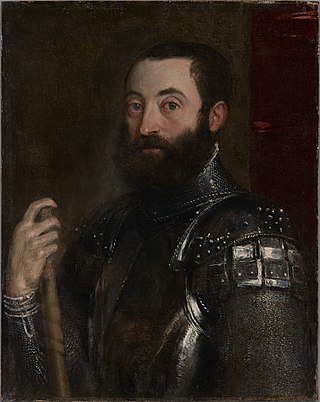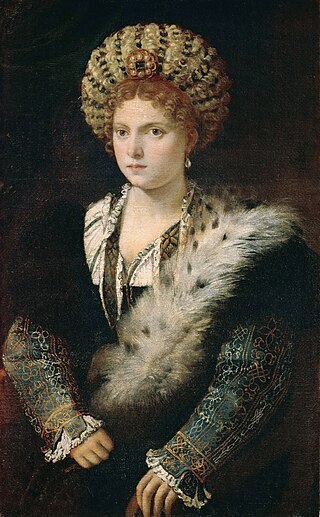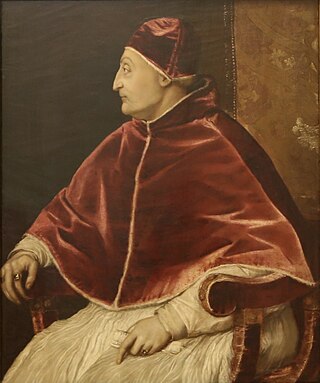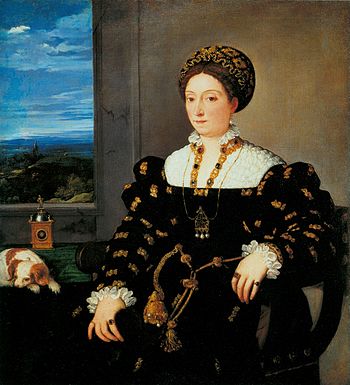
Isabella d'Este was the Marchioness of Mantua and one of the leading women of the Italian Renaissance as a major cultural and political figure.

The Venus of Urbino is an oil painting by Italian painter Titian, depicting a nude young woman, traditionally identified with the goddess Venus, reclining on a couch or bed in the sumptuous surroundings of a Renaissance palace. Work on the painting seems to have begun anywhere from 1532 or 1534, and was perhaps completed in 1534, but not sold until 1538. It is currently held in the Galleria degli Uffizi in Florence.

The Duchy of Urbino was an independent duchy in early modern central Italy, corresponding to the northern half of the modern region of Marche. It was directly annexed by the Papal States in 1631.

Portrait of Elisabetta Gonzaga is an oil on wood painting attributed to the Italian Renaissance artist Raphael, completed c. 1504–1505, and today housed in the Uffizi Gallery, Florence.

Vittoria della Rovere was Grand Duchess of Tuscany as the wife of Grand Duke Ferdinando II. She had four children with her husband, two of whom would survive infancy: the future Cosimo III, Tuscany's longest-reigning monarch, and Francesco Maria, a prince of the Church. At the death of her grandfather Francesco Maria della Rovere, she inherited the Duchies of Rovere and Montefeltro, which reverted to her second son, Francesco Maria, at her death. She was later entrusted with the care of her three grandchildren. Her marriage brought a wealth of treasures to the House of Medici, which can today be seen in the Palazzo Pitti and the Uffizi Gallery in Florence.

Guidobaldo II della Rovere was an Italian condottiero, who succeeded his father Francesco Maria I della Rovere as Duke of Urbino from 1538 until his death in 1574. He was a member of the House of La Rovere. Guidobaldo was an important patron of the arts in general, and of Titian in particular, commissioning his own portrait, and buying Titian's Venus of Urbino.

Francesco Maria II della Rovere was the last Duke of Urbino.

Elisabetta Gonzaga (1471–1526) was a noblewoman of the Italian Renaissance, the Duchess of Urbino by marriage to Duke Guidobaldo da Montefeltro. Because her husband was impotent, Elisabetta never had children of her own, but adopted her husband's nephew and heir, Francesco Maria I della Rovere. She was renowned for her cultured and virtuous life.

Eleonora Gonzaga, Duchess of Urbino (31 December 1493 – 13 February 1570 was Duchess and for sometime regent of Urbino by marriage to Francesco Maria I della Rovere, duke of Urbino. She served as regent during the absence of her spouse in 1532.

Portrait of Isabella d'Este is an oil on canvas painting of a young woman by Titian. It can be dated to the 1530s and is held in the Kunsthistorisches Museum, in Vienna. The artist and the date are undisputed. Beyond the museum documentation, there are several doubts about the person depicted.

Livia della Rovere was an Italian noblewoman of the House of della Rovere and the last Duchess of Urbino (1599–1631).

La Bella is a portrait of a woman by Titian in the Palazzo Pitti in Florence. The painting shows the subject with the ideal proportions for Renaissance women. In parallel the stringent composition corresponds to Titian's real portraits. The work can be dated by a letter about "that portrait of that woman in a blue dress" in May 1536.

Turkish Slave, also called Portrait of a Young Woman, is a painting by the Italian Mannerist artist Parmigianino. The painting was executed around 1533. It is housed in the Galleria nazionale di Parma.

The Portrait of Guidobaldo da Montefeltro is a picture by the Italian Renaissance artist Raphael, dating from around 1506 and housed in the Uffizi Gallery, Florence. It portrays Guidobaldo da Montefeltro, duke of Urbino.
Giulia della Rovere was an Italian noblewoman. A portrait of her by Titian survives in the Palazzo Pitti in Florence.

Portrait of Francesco Maria della Rovere is an oil on canvas painting by Titian, from 1536-1538. It depicts Francesco Maria I della Rovere, Duke of Urbino. It is held now in the Uffizi, in Florence. Signed TITIANVS F.[ECIT], it forms a pair with the same artist's Portrait of Eleonora Gonzaga della Rovere, Francesco's wife, also in the Uffizi.

Portrait of Pope Sixtus IV is an oil on panel portrait of Pope Sixtus IV by Titian and his studio, from c. 1540. It is held in the Uffizi, in Florence.

Portrait of a Knight of Malta is an oil on canvas painting by Titian, from c. 1515. It depicts a knight belonging to the Order of Malta. It is now in the Uffizi, in Florence.

Giulia da Varano, also known after her marriage as Giulia da Varano della Rovere, was an Italian noblewoman and member of the Da Varano family. She was the ruling Duchess of Camerino during 1527–1539 and by marriage Duchess of Urbino from 1534 until her death.

Vittoria Farnese, also known as Vittoria, Princess of Parma, and by her married name Vittoria Farnese della Rovere, was an Italian noblewoman, Duchess consort of Urbino from 1548 until 1574 by marriage to Guidobaldo II della Rovere, Duke of Urbino.


















